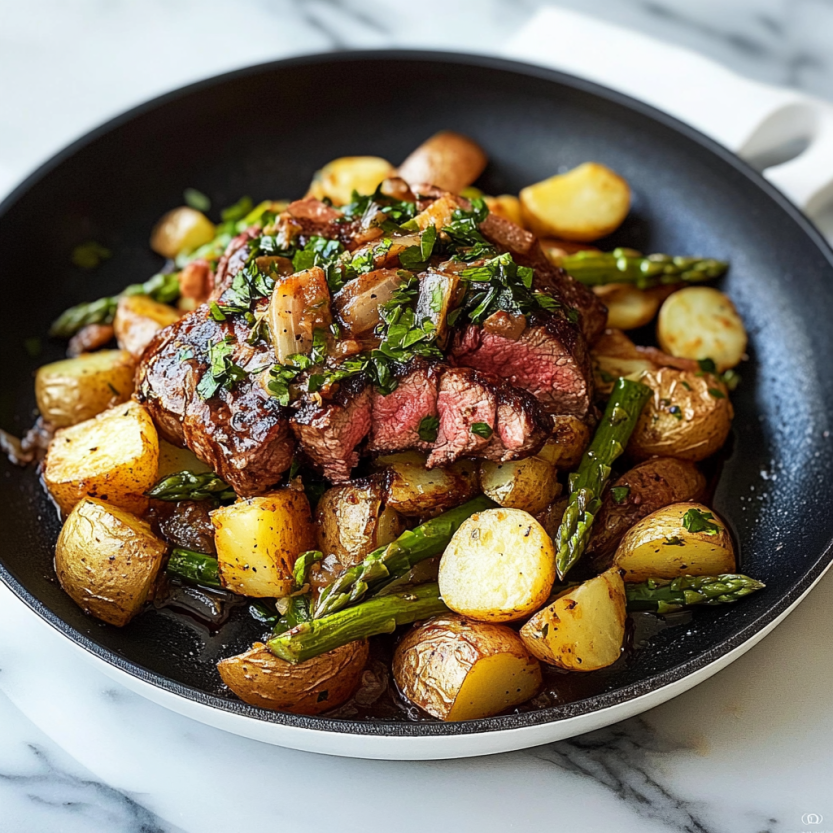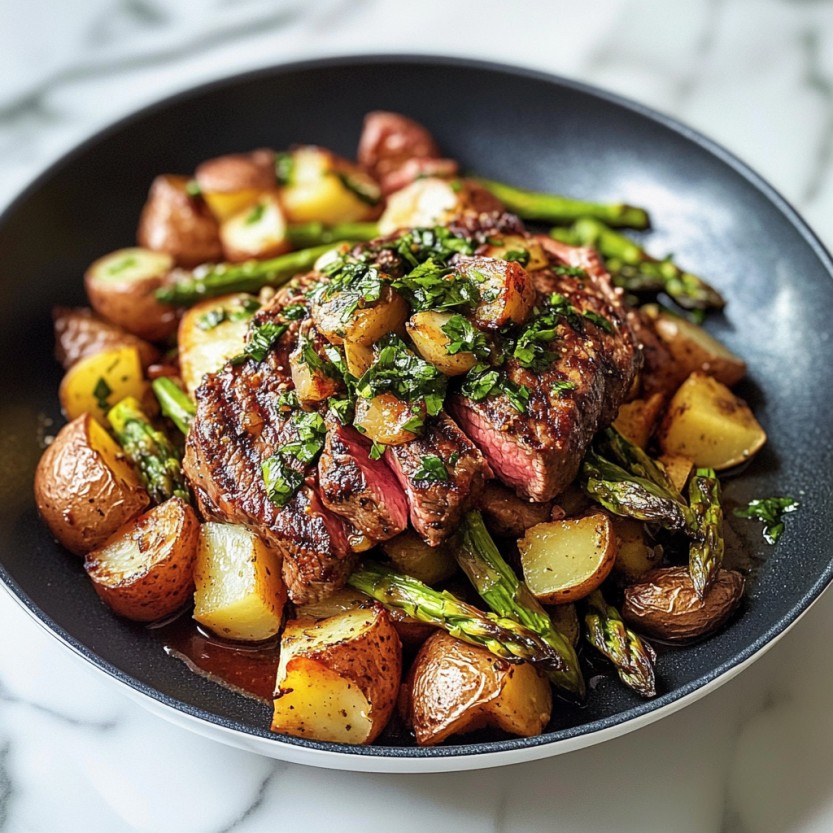 Save
Save
This skillet steak with asparagus and potatoes transforms your home cooking into restaurant-quality cuisine. The beauty of this one-pan dinner lies in its simplicity while delivering exceptional flavor. I discovered that cooking steak at home doesn't need to be intimidating after perfecting this foolproof method that yields tender, juicy results every time.
I created this recipe one evening when I wanted to impress my partner with something special but didn't want to spend hours in the kitchen. Now it's our go-to celebration meal that feels fancy without the fuss.
Ingredients
- Baby red potatoes Their waxy texture holds up beautifully during roasting and their sweet buttery flavor complements the steak perfectly. Choose firm potatoes with smooth skin.
- Extra virgin olive oil Use a good quality oil as it forms the flavor foundation for both the vegetables and the steak. The fruity notes enhance all components.
- Fresh asparagus Select bunches with tight closed tips and firm stalks for the best texture and flavor. Thicker stalks work especially well in this recipe.
- Smoked paprika This adds a wonderful smoky depth that elevates the steak beyond basic seasoning. Look for Spanish smoked paprika for authentic flavor.
- Garlic powder Provides even garlic flavor across the steak without burning like fresh garlic might at high temperatures.
- Sirloin or strip steak Choose well-marbled cuts that are at least 1 to 1.5 inches thick for best results. Bring to room temperature before cooking.
- Fresh herbs Parsley and mint create a bright, vibrant sauce that cuts through the richness of the steak. Always use fresh herbs here not dried.
- Lemon The zest and juice bring acidity that balances the rich steak and complements the roasted vegetables.
Step-by-Step Instructions
- Preheat and Prep
- Warm your oven to 400°F while you halve the potatoes and cut the asparagus. This ensures the oven is perfectly hot when you begin roasting the vegetables.
- Roast the Potatoes
- Toss halved baby potatoes in olive oil with a generous seasoning of salt and pepper in an oven safe skillet. The initial solo roasting gives them a head start since they take longer than asparagus. Look for them to just begin to soften after about 15 minutes.
- Add Asparagus
- Introduce the asparagus pieces to the partially roasted potatoes and drizzle with additional olive oil. This timing ensures both vegetables finish cooking simultaneously. The asparagus should remain vibrant green and tender crisp.
- Prepare the Steak
- While the vegetables finish roasting lower the oven temperature to 350°F. Brush the steak generously with olive oil before applying the spice mixture of smoked paprika garlic powder salt and pepper. This creates a flavorful crust.
- Sear and Finish
- Using the same skillet after removing the vegetables sear the steak over medium heat for 4 to 5 minutes per side to develop a beautiful crust. The oven finish at lower temperature ensures even cooking throughout for perfect doneness.
- Rest the Meat
- This 15 minute rest is critical. The juices redistribute throughout the steak making it incredibly tender and moist. Dont skip this step even if youre eager to eat.
- Make Herb Sauce
- While the steak rests whisk together the fresh herbs lemon and olive oil. The combination creates a bright acidic complement to the rich meat and starchy vegetables. The sauce ties all components together.
- Serve and Enjoy
- Slice the steak against the grain into thin strips and arrange with the vegetables before spooning the vibrant herb sauce over everything. The presentation resembles an upscale restaurant dish.
 Save
Save
This recipe converted me from a restaurant steak orderer to a confident home steak cook. The first time I made it my kitchen filled with an incredible aroma that reminded me of steakhouses my father would take us to for special occasions. The combination of that nostalgic smell with the modern fresh herb sauce creates something truly special.
Perfect Temperature Guide
Understanding steak doneness transforms your cooking results. For rare cook to 125°F for a cool red center. Medium rare at 135°F offers a warm red center with optimal tenderness and juiciness. This is my personal recommendation for this recipe. Medium at 145°F gives a warm pink center while medium well at 150°F leaves just a hint of pink. Well done at 160°F has no pink but tends to be drier.
Use a meat thermometer inserted into the thickest part of the steak for accuracy. Remember that during the resting period the temperature will continue to rise about 5 degrees.
Scaling for Company
This recipe easily doubles or triples for entertaining. When cooking for more than four people use two skillets to avoid overcrowding which would steam rather than sear the steak. Prepare the vegetable components ahead of time and keep warm while focusing on cooking the steaks to order. The herb sauce can be made up to 4 hours ahead and kept at room temperature.
Serving this meal to company has earned me countless compliments and requests for the recipe. The presentation on a large platter family style encourages conversation and sharing.
Seasonal Variations
Spring and summer Substitute half the asparagus with halved cherry tomatoes added during the last 5 minutes of vegetable roasting time.
Fall Replace asparagus with broccoli florets or Brussels sprouts adjusting cooking time as needed about 20 minutes total.
Winter Swap in hearty root vegetables like parsnips and carrots alongside the potatoes increasing initial roasting time to 25 minutes.
The core cooking method remains the same regardless of which vegetables you choose making this a versatile year round recipe that adapts to whatever looks freshest at your market.
 Save
Save
Recipe Questions
- → How do I know when my steak is cooked to medium-rare?
For medium-rare, the internal temperature should reach 130-135°F (54-57°C). After cooking in the oven for 10-12 minutes (following the searing step), use a meat thermometer inserted into the thickest part to check. Remember the steak will continue cooking slightly during the 15-minute rest period.
- → Can I substitute the herbs in the sauce?
Absolutely! While parsley and mint create a bright, fresh flavor profile, you can substitute with herbs like basil, cilantro, chives, or tarragon based on your preference. Just maintain the same quantities to preserve the sauce consistency.
- → What's the best type of skillet to use for this dish?
A cast-iron skillet works best because it can go from stovetop to oven and retains heat well for proper searing. If you don't have cast-iron, any oven-safe skillet will work, but ensure it's rated for high oven temperatures (up to 400°F).
- → Can I prepare any components of this meal ahead of time?
Yes! The herb sauce can be made up to 24 hours in advance and stored in the refrigerator. You can also pre-cut the asparagus and potatoes earlier in the day. For best results, the steak should be seared and cooked just before serving.
- → How can I adapt this recipe for more servings?
For 4 servings, double the ingredients but use two skillets to avoid overcrowding, which would steam rather than roast the vegetables and prevent proper searing of the steak. Divide the ingredients evenly between pans and follow the same cooking times.
- → What side dishes pair well with this meal?
This is already a complete meal with protein and vegetables, but you could add a simple green salad with vinaigrette or crusty bread to soak up the delicious herb sauce. A light dessert like berries with whipped cream would round out the meal nicely.